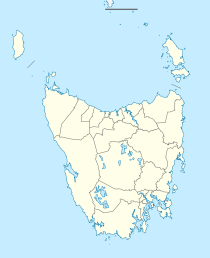Ravenswood, Tasmania facts for kids
Quick facts for kids RavenswoodLaunceston, Tasmania |
|||||||||||||||
|---|---|---|---|---|---|---|---|---|---|---|---|---|---|---|---|
| Postcode(s) | 7250 | ||||||||||||||
| Location | 3.5 km (2 mi) from Launceston | ||||||||||||||
| LGA(s) | City of Launceston | ||||||||||||||
| State electorate(s) | Bass | ||||||||||||||
| Federal Division(s) | Bass | ||||||||||||||
|
|||||||||||||||
Ravenswood is an eastern suburb of Launceston, Tasmania, Australia. It's a community with a rich history, starting as a small farming area.
Contents
History of Ravenswood
Ravenswood began as a farming area in the early 1800s. People first officially valued properties here in 1858. For many years, the only way to get to Launceston was by crossing a river ford. Farmers rode horses to sell their goods like fruit and eggs.
How Ravenswood Got Its Name
The name "Ravenswood" likely came from a large property owned by David McGown. This property was located near Distillery Creek. In 1836, Mr. McGown bought a lot of land there. He named his property "Ravenswood." Later, the whole area became known by this name.
Mr. McGown was a distiller, meaning he made alcoholic drinks. He had been a distiller in Scotland for 14 years before coming to Australia. He continued this business at Distillery Creek for six years.
Old Mills and Distilleries
Distillery Creek got its name for a clear reason. The Caledonian Distillery was built on Mr. McGown's land. His brother-in-law, James Towers, ran it. Nearby farmers would bring their grain to the distillery. In return, they received bottles of whiskey.
On the other side of Distillery Creek, there was once a flour mill. It was called Harden Mill and was built in 1857. This mill helped process grain into flour. It was later sold and eventually taken down in 1932 because it was unsafe.
Farms and Bridges
An early farm in the area was "Hiawatha Farm." It was bought in 1883 by Amelia Dean. This farm was first used to keep horses that pulled bread delivery carts. Over time, parts of the farm were sold for new developments. These included flood prevention projects, a railway line, and new houses.
In 1914, an agreement was made to build a bridge across the North Esk River at Henry Street. This bridge was built to be very strong. It even survived a major flood in 1929. The Launceston City Council replaced this bridge in 1968.
Another early bridge was built by George Hobler. He owned land at South Ravenswood. He built the first "Hobler's bridge" over the river at his own cost. Since then, two more bridges with the same name have been built in different spots.
Early Settlers and Homes
Some of the first settlers were the Towse brothers, who came from England. They built their first home out of stone. A small church was also built nearby, but it has since been taken down. Many early homes in Ravenswood were made of large stone blocks.
Timber from the bush was used to build a small hall on Mr. Gipton's property. This building is now the Ravenswood Gospel Chapel. It stands in front of the original Gipton house.
First School in Ravenswood
The first school in Ravenswood was built on land given by Robert Gipton. It had one school room and a four-room house for the teacher. Children came from many nearby areas to attend this school. At one point, about 60 students were enrolled. The school closed in 1940 because fewer children were attending. The building was later moved and now serves as a caretaker's home elsewhere.
Facilities
Ravenswood has many useful facilities for its residents:
- Two shopping centres
- Police station
- Volunteer Fire Station
- Skate park
- Hotel
- Over 50's club
- Community health centre
- Community centre
- Pharmacy
- Library
- Bakery
- Neighbourhood house
- Newsagent
- Church
- IGA Supermarket
- Bowls club
- Op Shop
- Bike Museum
- Mamas CAF
Education in Ravenswood
Ravenswood's population grew quickly in the 1970s. In 1976, a high school opened here. The number of students at the high school was highest between 1979 and 1984, with about 700 students. This was Tasmania's first "open plan" high school.
Over the years, student numbers went down. By the early 1990s, the high school was considered for combining with other schools. Today, Ravenswood has two schools. Ravenswood Heights was formed in 1996. It combined three local schools: Ravenswood High, Ravenswood Primary, and East Ravenswood Primary.
After this, Ravenswood Primary closed but later reopened as a special school. Ravenswood High became the senior campus for grades 6-10. East Ravenswood became the junior campus for grades 1-5, and also had a kindergarten. The senior campus closed at the end of 1999 due to low student numbers. Students then chose to attend nearby Brooks High School or Queechy High School.


